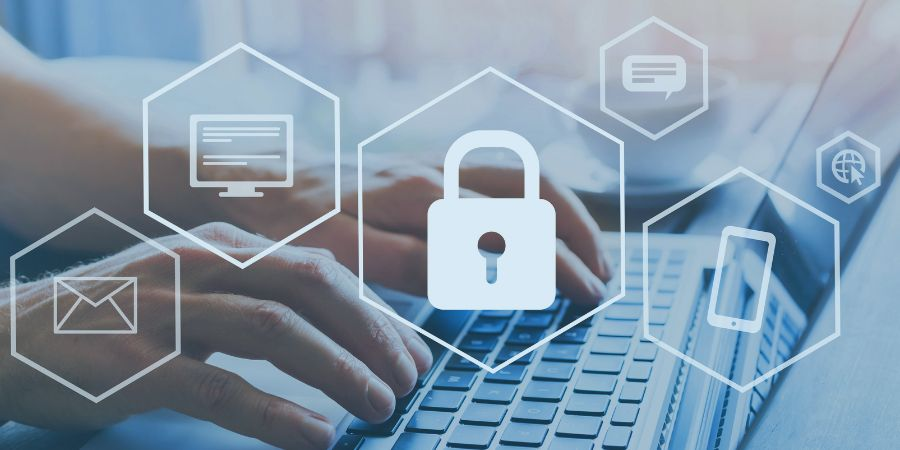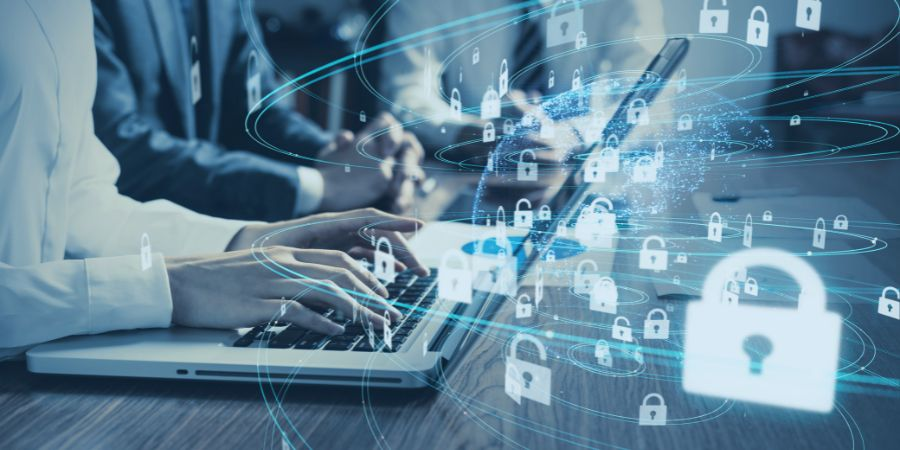How to Prevent Ransomware Attacks
Published on October 26, 2022
Last updated on April 02, 2024
Jump to a section
Improving Cybersecurity
As technologies develop, it gives cyber attackers access to more sophisticated tools that make ransomware a growing threat. Your organisation's readiness against these attacks can improve resilience and prevent unexpected disruptions that impact your organisational reputation.
Running a business in today's world is almost impossible without any form of online presence, and avoiding cybersecurity threats can be a challenging task. Threat actors behind ransomware usually have a technological advantage over regular employees not to mention that they are also highly skilled in computer science.
The Rise of Cyber Crime
Cyber attacks have increased exponentially in the past few years, and according to Hiscox Cyber Readiness Report, it was revealed that 3 in every 5 firms experienced a cyber attack recently. This is no coincidence that the increase in these attacks has coincided with the Covid-19 pandemic.
With many businesses changing the ways in which they operate, cybercriminals have echoed this by becoming increasingly sophisticated with the campaigns they are deploying and the tactics they are using, with cybercriminals as young as nine years old now getting in on the action.
As many organisations adapted to hybrid and online working and employees have adopted flexible hours (working outside core working hours), and on their own devices, this provided much more fish in the cyber sea for phishing to occur, which is why ransomware today is becoming increasingly problematic for organisations.
What's more, with further advancements in technology, including artificial intelligence and 5G, more data is being generated every day, creating more and more opportunities for ransomware attackers to take advantage.
For most organisations, it's not a matter of 'if' they will be targeted, but rather 'when' will their data and network be compromised, and what threats are headed their way.

What is Ransomware and Why It's a Growing Threat
Ransomware is a form of malware which encrypts a target's files, and then demands a ransom with a ransom note, in exchange for the restoration of access to the data for the target or victim.Successful attacks result in the victim being required to pay the ransom in order to access and decrypt files as per the ransom demands to access the data.
Even if local authorities are notified and the attack results in a temporary loss of access to files with the file encryption being quickly resolved, this loss of time can have a huge impact on a business's ability to fully recover from the attack. It is therefore vital for all organizations to protect themselves and their services as much as they can.
How does it work?
A ransomware attack can infect an operational system the same way as other malware, such as infected files in an email attachment, fraudulent websites, malicious URL, or suspicious links.
This can happen through social engineering where the attacker forms trust with the target through personalised messages before coercing them into opening an infected attachment in an email or clicking on malicious links. It allows them to access the computer and release the malicious file on the operating system, resulting in infected computers.
Thus begins the process of file-encrypting, where the malware holds files hostage until a ransom is exchanged before the decryption of the files is granted. Not only can this have an impact on a company financially, but it also has the potential to tarnish your business reputation.
Even if you click on a malicious link on the internet, and immediately disconnect, the ransomware infection will have already embedded itself in your files on your computer, including backup files, and you risk losing valuable files in the entire operating system.

A growing threat
Ransomware is not historically as prevalent as other forms of cyber security attacks, which is also why many organisations are not as well-prepared for it. But recently, the number of ransomware attacks on organisations and individuals has been on the rise. The impact of these attacks is far more than the cost of the ransom would ever equate to.
Since the first ransomware attack was recorded in 1989, attackers have become more sophisticated. They usually target one or more vulnerable areas in your cyber security infrastructure. You must have a solid vulnerability management strategy to prevent malware attacks and theft of critical data.
What Happens in a Ransomware Attack
Cybercriminals have become aware of companies' over-reliance on backups, thus resulting in the targeting of backups in some cases. Advanced ransomware has the capability of remaining undetected, laying low, and delaying an attack for months. In doing this, the ransomware is able to infiltrate your backups and backups of backups, leaving no files safe. Then when the attack is launched, your whole operating system is compromised and irrecoverably compromised; it's not a risk worth taking!
During a ransomware attack, the following is likely to take place:
Backups will be deleted and all the data is lost.
The most recent backups are available, but they are infected.
It takes the better part of a month for businesses to get back on track on average.
Reinfection could happen if all the malware is not eradicated properly from the backups, causing attack loops. This allows the ransomware to not only gain access but regain access to your files indefinitely.
Ransomware Statistics
According to research, approximately 67% of ransomware typically begins with a phishing email. To make matters more challenging, most ransomware attacks also target the backup systems in order to prevent the recovery of operating systems, and include data theft capabilities...making recovery incredibly challenging!
Because of this, you should be preventative rather than reactive in the case of ransomware, as it's often designed to exploit vulnerabilities and limit access to encrypted files on the computer and in the network.
According to Accenture, a ransomware attack occurred about every 11 seconds, resulting in an increase in attacks by 148% in 2021. WatchGuard reported a decline in unique ransomware variants, summarising that this was likely due to attacks now being mostly targeted, seeing a 888% increase in file-less malware, or threats using living-off-the-land (LotL) techniques'.

Learning About the Enemy
To not become a victim of a ransomware attack, company leadership needs to ensure that everyone in the organisation knows the enemy. Company executives should invest in training programs to increase their staff's cybersecurity awareness. In fact, they should also attend such programs themselves.
By partaking in cybersecurity training, attendees can learn more about the most common types of malware and how to deal with them effectively. It is an excellent occasion to ask the experts about the latest news on ransomware and get them to share some tips on protecting the company's computer systems and other valuable assets.
Evaluating the Level of Risk
After learning about malware such as rootkits, remote access trojans, and keyloggers, business owners need to evaluate how deadly a ransomware attack can be for their company. Here are a few key things to consider:
- How long can business operations be disrupted without a significant loss in revenue?
- How high of a recovery cost can the enterprise cover?
- Does the organisation have a backup of essential files and data?
- Does the company have the ability to restore the environment from a backup?
- How extensive and complex is the business network?
- Is there a plan in line for informing key stakeholders and customers about the attack?
- Is the executive board willing to pay the ransom to get the decryption key to restore network access? If yes, then to which extent?
- Have the organisation even been a victim of security failures and cyber-attacks in the past?
Answering these questions can help identify potential weaknesses in the company's infrastructure. This, in turn, is the critical step in developing a successful response plan.

Developing a Cyber Incident Response Plan
Although creating a response plan cannot prevent attackers from gaining access to the company's website and files, it is the best solution to minimise the damage. Even when only one segment of the business is compromised, having a plan for such an occasion can be a significant advantage.
Most cyber incident response plans outline vital elements that organisations need to protect. These can range from financial services to project management software. The main goal here is to provide additional protection for critical assets that allow the business to carry out everyday operations.
Besides, companies should devote some time to assessing vulnerabilities in their security systems. They can better prepare for dealing with the attacker by finding the weakest link in the chain. For instance, they can add more security measures to detect and stop malware before it spreads to other services.
Organisations should also take necessary steps to ensure everyone knows what to do after the attack. When it is too late to prevent the data from being stolen, deleted, or encrypted, every department should know what tasks it needs to complete from customer service and marketing to sales and human resources. This way, the firm can quickly get back on track and minimise the loss of money due to the long break in providing their services.
Benefits of Protecting Against Ransomware
Cybercrime Magazine reports that the global cost of ransomware attacks has reached a total of $20 billion (as of 2021). It means the ransomware threat has grown 5,700% in the last six years!
There is no better time than now for organizations to focus on resilience against these ransomware attacks. Building the right defence strategies is important to ensure that these attackers can't penetrate your organization. It's also vital for businesses to prioritise ransomware readiness as part of their cybersecurity efforts.
The following are the benefits of protecting and implementing readiness campaigns against ransomware.
Business Continuity
Ransomware attacks can disrupt your business operations, especially when crucial systems and data are compromised during the attack. But when you protect critical data and entry points for attackers, you can ensure business continuity. Even when there is an attack, your incident response team will know how to handle the situation and the ransom demand to prevent the situation from escalating and becoming a widespread ransomware attack.
Data Protection
Suppose your business deals with critical customer data or other important data. In that case, you must have a ransomware readiness plan to avoid potential loss when you are under cyber threats.
Disaster Recovery
It's no secret that all businesses, especially those using cloud technologies, cloud services, and other software are most vulnerable to cyber threats. Even when disruptions happen, having a ransomware preparedness plan ensures a faster recovery from these attacks. It reduces the risk and enables you to plan how to recover faster from these extortion schemes.

Ransomware Examples and Prevention
One of the best tips on how to prevent ransomware attacks is to learn from the previous attacks. By looking at examples, you can better analyse ransomware threats and the measures you must take to prevent them from happening to your organisation.
Below are some of the biggest examples of ransomware attacks in recent years and some important lessons you should take to improve your ransomware protection.
Cryptolocker
The Cryptolocker ransomware attack in 2013 is one of the biggest ransomware attacks in recent years. The attack involved trojan software that targeted Microsoft Windows computers. The malicious software proliferated through infected email attachments, which, when activated, encrypted certain files stored in local network drives.
Once the malware was activated, it displayed a message asking for payment to be sent via Bitcoin or pre-paid cash voucher. If no payment was made, the attackers threatened to decrypt the files via an online service, or they will command a higher price.
Wannacry
Another major example of a ransomware threat is Wannacry. The attack spread to over 100 countries within 24 hours. The attack, like CryptoLocker, affected computers running Microsoft Windows operating systems. Specifically, it affected those running the Windows Server 2003 and 2008. The attackers only collected $140,000 in payment, but the global damage amounted to 4 Billion USD.
Petya
Petya is a ransomware attack that occurred in 2016. This ransomware infection works by infecting the master boot record of a computer, which overwrites the bootloader of the computer, forcing it to restart.
Once the computer restarts, the malware encrypts the file system and demands payment via Bitcoin. A recent ransomware attack took place in 2017, which followed a similar pattern.
Jigsaw
This was another ransomware attack in 2016 that was officially named BitcoinBlackmailer.It was named Jigsaw because the screen displaying the message from the ransomware attackers featured the prominent image of Billy the Puppet from Jigsaw.
The infection spread through malicious attachments in spam emails. Once the infection is activated, it will encrypt the files within the computer and the master boot record. The attackers had a unique request since they not only demanded money. They also threatened to delete one file for every hour that the ransom wasn't paid. The entire files and network system were wiped out within 72 hours of non-payment.
BlackCat
One of the most notorious cyber extortionists, BlackCat recently upped the ante by creating a website allowing customers and employees of their target to check for themselves if their data was compromised.
By doing this, the hope was that these customers and employees would put pressure on the targeted organization to pay the ransom, in order to recover their own data including social security numbers, date of birth, phone numbers, email addresses, and other information mostly from the employees rather than customers.
Additionally, having these data packages of each employee visible on a public website, left them more vulnerable to other criminals piggybacking, and turned this into an urgent matter for the targeted organization to resolve the problem quickly.
The time sensitivity of the matter gave the targeted organization fewer options where paying the ransom appeared to be the most logical solution. Though potentially time-consuming for the attackers to set up a website, it proved an effective tactic in monetising the attacks. Ransomware attackers are always developing and looking for more innovative ways to ensure financial gain from their attacks.

Best Practices for Preventing Ransomware
Using the above examples of ransomware threats and attacks highlights the importance of identifying security gaps and boosting the security infrastructure to prevent future attacks. Another way to prevent malware threats is to work with security professionals and prioritise ransomware protection in cybersecurity efforts.
As the internet is home to many other dangers than just ransomware malware, following a few simple safety rules is the wisest decision everyone can make. Here is a quick rundown of the most important tips to stay safe online:
Practising safe browsing
To prevent personal data from being stolen by hackers, everyone should visit only safe parts of the web. By enabling privacy safeguards on firm computers, C-suits can prevent their workers from entering dangerous sites that can be the source of potential attacks.
Creating backups
Creating a backup of crucial data is the best way to avoid making a hefty payment to hackers and boost the security and risk management of the organisation.
Using complex passwords
Paying a ransom always leaves a bitter taste in the mouth of every CEO. Nonetheless, it can be incredibly excruciating if the attacker places ransomware in the company's system by guessing the password to its email inbox. To prevent this from happening, companies should incentivise using complex passwords.
Prevention is a priority
Preparedness is the best way to beat malicious activity. Your company should invest in security awareness training to educate employees about identifying risks and threats on the internet. The user training must be overseen by a certified cybersecurity professional. It also pays to conduct a regular vulnerability assessment to overcome security vulnerabilities. The point is to identify ransomware threats and areas where they could possibly spread ransomware infections. It is also a good idea to do network segmentation so that when you're attacked, the entire network is not compromised.
Deploy security tools
You need security tools, such as anti-malware software and antivirus software, as part of your security protocols. Make sure that these security tools are regularly updated to ensure they can manage any level of security vulnerabilities.
Keep systems up-to-date
Regularly update your operating systems, applications, and software. Using updated software and systems ensures you can close the security gaps attackers might want to exploit. You can switch on the auto-updates to automatically update your systems' security.
Implement an IDS
An IDS or Intrusion Detection System alerts you when there is any suspicious activity or network traffic. A robust IDS helps you detect potentially malicious attacks before they happen.
Test your business continuity plan
Test your business continuity plan in case of an attack, and make adjustments where vulnerabilities or weaknesses are exposed. Fill out an impact analysis report to assess your contingency plan. Monitor your data resilience weaknesses and resolve them as soon as they are detected during regular simulations and tests.

What to Do if You're Already Infected
If you suspect your organisation has already succumbed to a cyber attack, take the following steps to help reduce the damage after ransomware detection:
- Disconnect the infected computer, mobile device, or another device by both physically unplugging and disconnecting from the network and internet.
- Consider shutting off the wifi and disabling all core network connections.
- Reset all passwords without locking yourself out of the systems you need for recovery.
- Do a hard reset, wipe all affected devices, and prepare for reinstallation.
- Ensure the device is free from malware prior to restoring files.
- Reconnect devices to the clean network.
- Run antivirus software, and make sure everything is up to date.
- Monitor and scan the network for remnants of the virus that may still be hiding somewhere.
- Reinstall the backup after it is deemed safe, and watch out for future risks and threats, including phishing and suspicious emails and malicious links!

The Bottom Line
Not all businesses will be a target for malicious attackers. But you must have a cyber incident response plan and ransomware protection measures even when you don't need them, rather than realise later that you've already failed at protecting your critical assets.
Use the strategies and tips above to help you formulate a solid plan to mitigate these risks and ensure you can manage any threat.
In addition to the other protective measures, security software can also assist in detecting ransomware and ransomware attackers.
C2's Meridian allows you to create, store, manage, and distribute business continuity plans through smart automation and data collection. On top of this, we have created a host of business resilience tools that allow you to view and report on the data that matters most to your organisation, track your actions, and communicate any incidents that may occur through our innovative incident management. Book a demo today to see it in action.
Written by Richard McGlave
Founder & CEO at Continuity2
With over 30 years of experience as a Business Continuity and Resilience Practitioner, Richard knows the discipline like the back of his hand, and even helped standardise BS25999 and ISO 22301. Richard also specialises in the lean implementation of Business Continuity, IT Service Continuity and Security Management Systems for over 70 organisations worldwide.


Written by Richard McGlave
Founder & CEO at Continuity2
With over 30 years of experience as a Business Continuity and Resilience Practitioner, Richard knows the discipline like the back of his hand, and even helped standardise BS25999 and ISO 22301. Richard also specialises in the lean implementation of Business Continuity, IT Service Continuity and Security Management Systems for over 70 organisations worldwide.